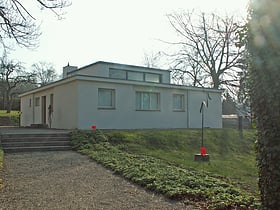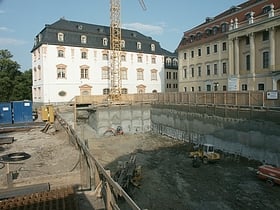Weimar: Museum
Places and attractions in the Museum category
Schloss Belvedere
Baroque palace and large landscaped park Nestled in the charming city of Weimar, Schloss Belvedere is a baroque masterpiece that beckons visitors with its historical elegance and architectural grandeur. This castle, situated just a few kilometers outside the city center, offers a glimpse into the opulent past...
Goethes Gartenhaus
Goethe's Garden House in the Park an der Ilm zu Weimar was a place of residence and work of Johann Wolfgang von Goethe. It has been a UNESCO World Heritage Site since 1998 as part of the "Classical Weimar" ensemble.
Schloß Tiefurt
Nestled in the cultural city of Weimar, Germany, Schloß Tiefurt, also known as Tiefurt House, is a charming historical site that offers a glimpse into the rich heritage of the region. This elegant manor house, surrounded by an idyllic park, was once a summer residence...
Bauhaus-Museum
The Bauhaus-Museum in Weimar, Germany, stands as a testament to the revolutionary Bauhaus movement that has left a lasting impact on art, design, and architecture worldwide. Founded in 1919 by Walter Gropius, the Bauhaus school merged fine arts with crafts, leading...
Classical Foundation Weimar
The Klassik Stiftung Weimar is one of the largest and most significant cultural institutions in Germany. It owns more than 20 museums, palaces, historic houses and parks, as well as literary and art collections, a number of which are World Heritage Sites.
Goethe House
The Goethe House is the main house lived in by the writer, poet, and statesman Johann Wolfgang von Goethe whilst in Weimar, Germany, though he did live in several others in the town. The home serves as the main location of the Goethe-Nationalmuseum.
Goethe-Nationalmuseum
The Goethe-Nationalmuseum is a museum devoted to the German author Johann Wolfgang von Goethe, in the town of Weimar in Germany.
Haus am Horn
UNESCO-listed Bauhaus building The Haus am Horn is a domestic house in Weimar, Germany, designed by Georg Muche. It was built for the Bauhaus Werkschau exhibition which ran from July to September 1923.
Duchess Anna Amalia Library
Court library with an ornate Rococo hall The Duchess Anna Amalia Library in Weimar, Germany, houses a major collection of German literature and historical documents and is part of the UNO designated Classical Weimar.
Nietzsche-Archiv
The Nietzsche Archive is the first organization that dedicated itself to archive and document the life and work of the philosopher Friedrich Nietzsche, all sourced from Elisabeth Förster-Nietzsche, the philosopher's sister.
Bauhaus Museum Weimar
The Bauhaus Museum Weimar is a museum dedicated to the Bauhaus design movement located in Weimar, Germany. It presents the Weimar collections of the State Bauhaus, which was founded in the town in 1919. The museum is a project of the Klassik Stiftung Weimar and is located near the Weimarhallenpark.
Gedenkstätte Buchenwald
Nazi and Soviet concentration camp site Buchenwald was a Nazi concentration camp established on Ettersberg hill near Weimar, Germany, in July 1937. It was one of the first and the largest of the concentration camps within Germany's 1937 borders.
Museum für Ur-und Frühgeschichte
The Museum of Prehistory and Early History of Thuringia in Weimar combines a museum with a 1000 m² exhibition area and the Thuringian State Office for the Preservation of Monuments and Archaeology under one roof, which is the sponsor of the museum.
Wittumspalais
The Wittumspalais is a museum in Weimar operated by the Klassik Stiftung Weimar. The building was the longtime widow's residence of Duchess Anna Amalia and formed a center of social and literary life in Weimar during her lifetime.
Haus Hohe Pappeln
The house "Hohe Pappeln" is the former home of Henry van de Velde in Weimar and is now used as a museum by the Klassik Stiftung Weimar.
Römisches Haus
The Roman House is a building on the edge of the Park on the Ilm River in Weimar and has been a UNESCO World Heritage Site since 1998 as part of the "Classical Weimar" ensemble.
Map





















